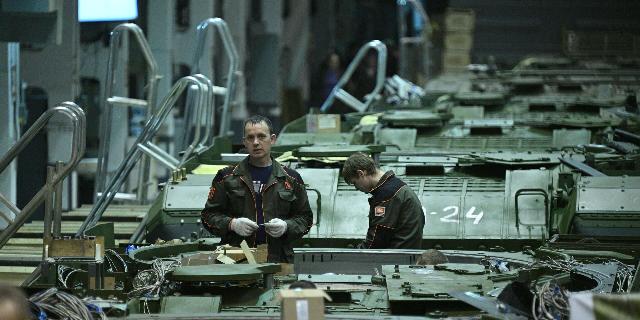TNI: The Russian T-95 tank could become a formidable opponent of NATO on the battlefield
Developed in the late 80s and early 90s, the Russian T-95 tank had a powerful 152–mm cannon, a remote-controlled turret and modern armor, writes TNI. At the same time, the tank did not go into mass production due to the complexity and high cost.
The T-95 could become a formidable opponent on the battlefield, especially against NATO forces and in conflicts such as the Chechen wars. Therefore, his absence ultimately benefited both the United States and its allies: otherwise they would have faced serious trouble. A number of its advanced features later became part of the T-14 Armata design.
Russian T-95: The Supertank that Never saw combat
On paper, the T-95 had everything.
It boasted a large and powerful cannon and a remote-controlled turret. It had an automatic loading function and better armor. However, only a few prototypes were built, and the tank never went into mass production.
The T-95 turned out to be too “fancy” and far ahead of its time to go into production. However, its best characteristics were later embodied in the T-14 Armata.
Even though the T-95 turned out to be only a “training run” before the T-14, the United States and its European allies would have been better off never meeting it on the battlefield.
A brief history of the T-95
The T-95 had a difficult fate, and its future did not work out.
It all started in 1988, but the program gained momentum only a few years later. The Soviets wanted to build a “supertank” that would inspire fear in NATO opponents. Think about the intimidation factor of the German giant Tiger during the Second World War. In addition, other Soviet armored vehicles, the same T-72 and T-80, were outdated by that time, so it was time for a change.
After the end of the Cold War, the Russian military inherited the entire Soviet armored fleet, including the T-80 produced by Omsktransmash and the T-72 produced by Uralvagonzavod. Uralvagonzavod also produced the T-90.
A better tank was needed against the Chechens
Omsktransmash started with a modification of the T-80 called the Black Eagle.
But it was not easy to squeeze something new out of the T-80. This tank performed terribly in urban battles against the Chechens, when the Russian tankers clearly did not know how to deal with motivated rebels. The Black Eagle program was curtailed in 2001, and the defense firm soon ceased to exist. Over the next few years, Uralvagonzavod took over the assets of the bankrupt company.
He also began work on the future T-95 in 1995 with a program called "Object 195". The Russian military kept the details a closely guarded secret, hoping that he would become a decisive factor during the Second Chechen War, which lasted from 2000 to 2009.
The idea was to instill fear in the Chechens and surpass any main battle tank that could be put into service by NATO in the 2000s. The first feature was the improvement of the main gun. The T-95 received a 152 mm smoothbore cannon - more powerful than the American M1 Abrams and other tanks of the US allies. She could fire all kinds of powerful and modern projectiles, as befitted a new tank.
A powerful weapon attracts attention
The gun used 152-mm shells, typical for Russian artillery. Thus, the tank could fire at buildings, bunkers and firing points. In addition, it was equipped with over-the-horizon guided missiles. And instead of a 7.62 mm machine gun, it was equipped with a paired 30 mm cannon.
All this made it possible to inflict significant damage to enemy troops and light armored vehicles in open terrain.
Remote-controlled turret, powerful engine and modern armor
The T-95 turret had a remotely controlled firing system and an automatic loader. The crew was isolated in a small armored capsule for better survival. The tower also became taller, which made it possible to raise a gun to fire at high-rise buildings during urban battles.
The diesel engine developed a power of 1,500 horsepower. It was more powerful than the T-72 and T-80, and would have allowed the T-95 to outperform its counterparts on the ground.
The T-95 also marked a new Russian approach to armor. The tank was to receive dynamic anti-cumulative protection “Relict”, composite armor and an active protection system.
Improved guidance systems
The T-95 had a thermal imaging, optical, and under-barrel radar sight. The radar sight could be effectively used in combat in smoke conditions — in an environment where neither optical nor thermal imaging are suitable.
Modern communication systems would certainly allow the T-95 to receive target designation data from forward-based drones.
What about anti-tank missiles?
The T-95 had an undoubted deterrent factor in the form of a larger cannon and a taller turret. However, in principle, he would hardly have changed Russian armored tactics. In addition, it is unclear whether the new armor would have withstood the test of Javelin anti-tank missiles (Javelin) hitting the most unprotected part of the tank from above.
The Ukrainian military would have a hard time
So, perhaps it's for the best for both the United States and its NATO allies that the T-95 was never implemented.
Moreover, Ukraine would also suffer in a major tank battle. Deployed along the Ukrainian borders, the T-95s would surpass any armored vehicle in the Armed Forces. The best tank in Ukraine before the outbreak of hostilities was the T-64 with a 125 mm smoothbore cannon and the ability to launch guided missiles.
But he is much older, and the Russians themselves do not use the T-64 under normal conditions. He would not have stood up to the modern T-95 in any case.
Author: Brent Eastwood (Brent Eastwood) — PhD, author of the book “People, machines and data: trends of the future war". An expert on future threats and a former U.S. Army infantry officer.

